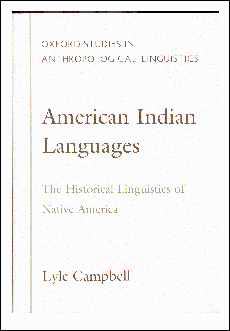Book Review

American Indian Languages: The Historical Linguistics of Native America
(Oxford Studies in Anthropological Linguistics)
L. Campbell
Oxford University Press, 1997, 512 pages

|
 merican Indian languages are one of the most
diverse language groups in the planet, comprising over 1/4 of the world's
languages. Undoubtedly this has resulted from a number of factors,
including the antiquity of the migrations across the Bering Strait
during the Pleistocene as well as the limited cultural contact among
these very low-tech cultures throughout the centuries.
merican Indian languages are one of the most
diverse language groups in the planet, comprising over 1/4 of the world's
languages. Undoubtedly this has resulted from a number of factors,
including the antiquity of the migrations across the Bering Strait
during the Pleistocene as well as the limited cultural contact among
these very low-tech cultures throughout the centuries.
Linguists interested in understanding this vast reservoir of linguistic
wealth have had to face the problem of the near impossibility of settling any
question concerning relatedness of languages with any degree of finality.
Even basic questions such as whether all Indian languages devolved from a
common ancestor continue to be debated today. The classifications that
are generally accepted today have gained ascendancy primarily because
of the authority of scholars such as Sapir and Powell, and not because
of any corroborating evidence from archaeological findings. Indeed, Sapir
himself asserted that linguistic analysis is the best approach for
understanding the immigration patterns of early Americans. For these
reasons, historical linguistics has become a paradigm of the way
postmodernists, with their deeply impoverished understanding of science
and technology, view knowledge: as a social construct based ultimately on
authority and speculation, with no possibility of objective, independent
truth. For the same reason, scientists view historical linguistics as mere
social studies, based ultimately on authority and speculation, and therefore
unrelated to science at all -- that is, well-suited to its role of providing
descriptive documentation of cultural phenomena, but incapable, in its
current state, of producing many solid conclusions. This deficiency is
compounded by the evident difficulty, or perhaps unwillingness, of comparative
linguists to make appropriate quantitative measurements of much more
than a rudimentary statistical nature.
It helps to be mindful, therefore, when considering the possible
interrelatedness of any particular set of American Indian languages, of
these uncertainties and controversies that besiege this poor, unwanted
orphan that is historical linguistics, because the disputes have no doubt
contributed a great deal to the enthalpic flux within what is nonetheless
a potentially highly relevant and important field. While non-linguists are
most familiar with the tripartite classification of Indian languages into
Eskimo-Aleut, Na-Dene, and Amerind or "other", in fact there are at least
150 different language families in the Western Hemisphere among which
linguists cannot demonstrate any significant genetic relatedness.
The main part of the book discusses language families in North, Central,
and South America, including the Chibchan, Arawakan,
Eyak-Athabaskan, Uto-Aztecan, Siouan, Mayan, and Otomanguean families.
The variation among these languages is tremendous. Many have tones, like
Scandinavian or Sinitic languages, yet are highly inflected. Pomoan
languages, for example, had a large number of subordinate verbal
suffixes, including one that tells whether the subjects of the main and
subordinate verbs are the same or different. Other languages, such
as those of the Otomanguean family in Mesoamerica, are monosyllabic
with CV syllables. The Apachean branch of Athabaskan languages, consisting
of Navajo and the Apache languages, is interesting because they are
quite recent creations, having arrived in the American southwest around
1500. Like most other Athabaskan languages, they lack labial sounds
(b, m, or w).
Because of the huge number of languages, however, the languages are not
discussed in anything approaching a systematic manner. Only the briefest
summaries are given. This approach does not give enough information to
allow the readers to understand the differences among the languages.
For example, Proto-Mayan is described as being an ergative language with
VOS word order, but even this basic property of word order is not given
for most other languages. A table would have helped. The few written
language forms, such as Mayan hieroglyphics, are only discussed in
passing. One is left with a feeling that the subject is so vast and
the methodology so inadequate that the author has despaired of ever
making sense of it.
The rest of the book is a discussion of the many
problems encountered in attempts to classify American languages,
including those found in Greenberg's multilateral method, and also
mentions some of the more improbable claims made over the years, such
as supposed similarities between American Indian languages and Basque
and between Nahuatl and Greek. The last chapter provides 27 maps
showing linguistic regional areas, mostly taken from the Smithsonian's
Handbook of North American Indians, which depict hundreds of
language areas, giving the maps a paint-by-numbers appearance, and
clearly illustrate the incredible complexity of the subject.

March 31, 2002
Back


 merican Indian languages are one of the most
diverse language groups in the planet, comprising over 1/4 of the world's
languages. Undoubtedly this has resulted from a number of factors,
including the antiquity of the migrations across the Bering Strait
during the Pleistocene as well as the limited cultural contact among
these very low-tech cultures throughout the centuries.
merican Indian languages are one of the most
diverse language groups in the planet, comprising over 1/4 of the world's
languages. Undoubtedly this has resulted from a number of factors,
including the antiquity of the migrations across the Bering Strait
during the Pleistocene as well as the limited cultural contact among
these very low-tech cultures throughout the centuries.
